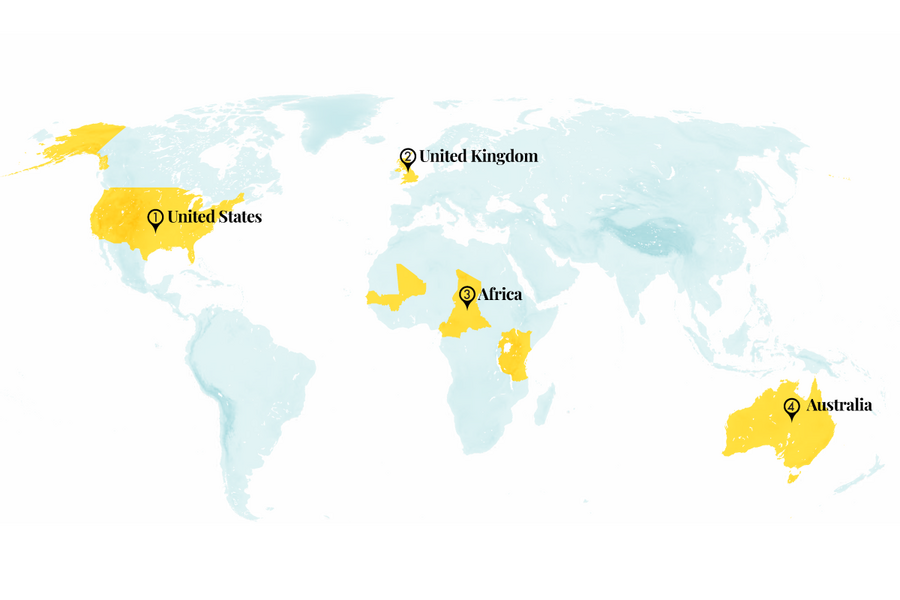Good news around the globe: Pulling up concrete and putting solar on renters’ roofs
Loading...
More American students are learning Indigenous languages in public schools
During the 2022-2023 school year in Oklahoma, 3,314 students from elementary to high school took part in an Indigenous-language program, a threefold increase from two years prior.
Oklahoma schools, which enroll at least 158,000 Native American students, have taught tribal languages since 2014 – when the right to take Indigenous language for high school credit was made a state law. The Cherokee and Chocataw languages have the highest participation rates and are offered most often.
Why We Wrote This
In our progress roundup, a Portland, Oregon, group that digs up paved surfaces has inspired others to reap the climate benefits. And in sunny Australia, governments are encouraging landlords to install solar and help meet emissions goals.
In June 2021, the Department of the Interior began acknowledging the United States’ role in 150 years of abuse of Native American children, who were punished for speaking tribal languages at federally funded boarding schools. For cultures around the world, the United Nations declared its decade of support for Indigenous languages in 2022, warning that all but a few hundred spoken languages out of thousands are endangered.
At Bartlesville High School in Oklahoma, just minutes from the Osage Nation Reservation, tribal-language classes are popular among both Native and non-Native students. “There definitely has been an uptick in the last couple of years of just students wanting to know more about their heritage, the culture [and] the culture that is around them,” said Principal Michael Harp.
Sources: Oklahoma Voice, Solutions Journalism Network, Oklahoma State Department of Education
In the United Kingdom, African visa-holders are filling gaps in elder care services
A 2021 report from the U.K. government’s Migration Advisory Committee attributed growing worker shortages in Britain’s care system to the pandemic and the impact of the United Kingdom leaving the European Union, which ended the free movement of workers. With the addition of care staff to the list of occupations for which the government provides work visas, Africans now make up the majority of foreigners working in Britain’s care sector.
Some 57,000 Africans, mostly from Nigeria and Ghana, entered the U.K. on a health and care visa in 2023 – up from 20,000 in 2022. Rights advocates say that U.K. jobs are well paid relative to those in many African countries, but not by European standards. They also point out a recent decision to prohibit care workers from bringing their families to the U.K. But for workers facing high cost of living and unemployment in Africa, home to the world’s youngest population, health care jobs in the U.K. may represent better opportunities. Source: Semafor
Farm by farm, smallholders in Africa have reforested an area nearly seven times the size of New York City’s Manhattan
Africa loses 3.9 million hectares (15,058 square miles) of rainforest and dry forest each year, owing largely to industrial and subsistence agriculture. Lacking long-term support or the proper species, many tree-planting programs fail. The nonprofit Trees for the Future may be an exception: Since 2015, its “forest garden” initiative has restored more than 100,000 acres of degraded farmland in nine countries.
On the shores of Lake Victoria in Kenya, farmers meet to train and access tools and seed banks to replace their monocultures with forest gardens. A plot’s outer perimeter is lined with trees that act as a living fence, and in the center are vegetables and orchards bearing fruits such as mangoes and oranges. Each plot can have around 5,800 trees. Harvests provide a food source for families, and any excess can be sold for a profit. Though the benefits provided by old-growth forests accrue over centuries and cannot be fully replaced by planting new trees, Trees for the Future says its agroforestry approach breaks cycles of poverty and benefits the land. The organization has reached about 340,000 people and was named a World Restoration Flagship by the United Nations.
Sources: The Guardian, Chatham House
More rental homes are getting solar power
Australia has the highest per capita solar capacity installed in the world, with photovoltaic panels providing power for about one-third of homes. But these benefits have been largely out of reach for the one-third of Australians who are renters or live in government-subsidized housing, with only 4% of rental households powered by the sun.
As the homeowner market for solar becomes saturated and the federal government pushes to meet clean energy targets, it is encouraging landlords to invest in rooftop solar. Federal programs offer incentives for solar technology such as rebates on panels and water heaters. State governments offer their own subsidies, including payments for excess solar energy sold to the grid. An Australian innovation, SolShare is a software and hardware solution that allows as many as 10 apartments to share solar energy from one rooftop system.
Though some renters worry that solar installations could justify rent increases, many see them as a cost-effective way of lowering carbon emissions. Australia hopes to generate 82% of its electricity with clean energy by 2030.
Sources: Context, Clean Energy Council
Cities around the globe are depaving
Stripping away unnecessary concrete and asphalt replaces impermeable paving with plant life. This can lower the urban heat island effect, allowing rainwater to soak into the ground; reduce runoff and flooding; provide sanctuaries for wildlife; and boost well-being for residents.
In Portland, Oregon, the nonprofit Depave and its volunteers have removed six football fields’ worth of hard surfaces since 2008. Depave targets disenfranchised communities, where fewer shade trees and more paved surfaces make the environment hotter on average than in other neighborhoods.
In the Canadian province of Ontario, the nonprofit Green Venture has planted 2,850 native plants in Hamilton to help prevent runoff into nearby Lake Ontario, the source of the city’s drinking water. Leuven, Belgium, is depaving a suburb of 550 people, Spaanse Kroon. The city’s “tile taxi” will come to residents’ homes so they can dispose of asphalt or cobblestones they’ve removed. A suburb south of Paris recently depaved 11 acres of parking lots in a forested area.
Proponents cheer community-led and small-scale depaving, but they say municipal governments must devote significant resources to greening cities. “It starts with people pushing their government and starting these conversations on a small, local level,” said Depave’s Katherine Rose. “That’s how it takes hold.”
Sources: BBC, Reasons To Be Cheerful, Green Venture










